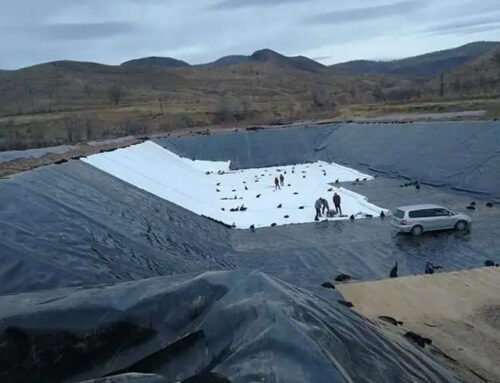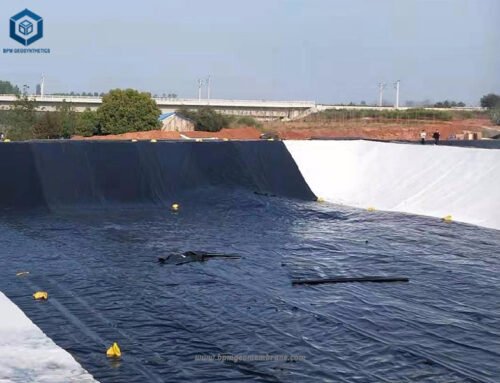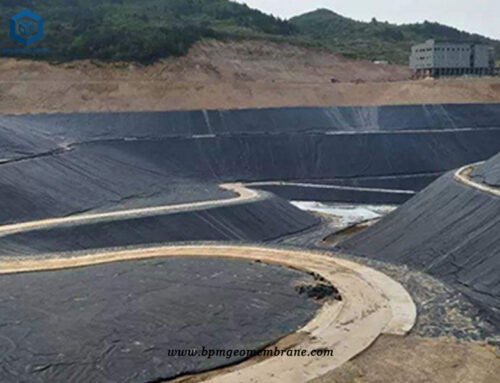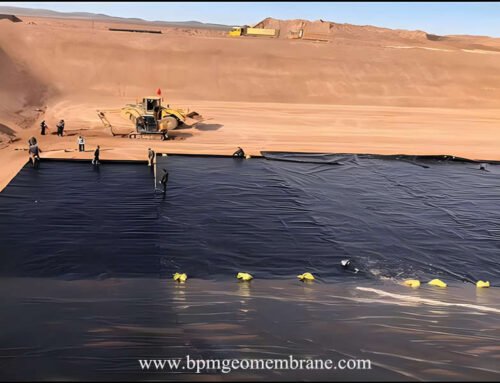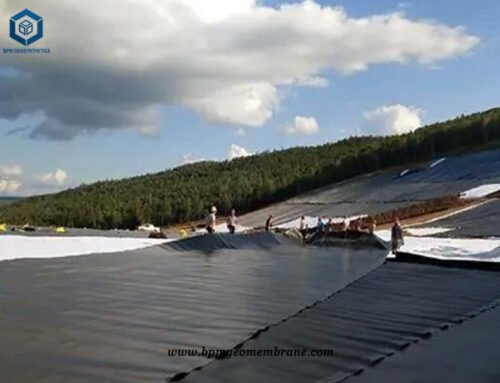High density polyethylene liner is the impermeable synthetic HDPE geomembrane used for geotechnical engineering projects so as to control fluid or gas migration or seepage in the human-made project such as canal, aquaculture, irrigation ponds and remediation liners and other lining applications include landfills, waste water treatment lagoons, oil and gas exploration and power plants, etc.
1. What Is High Density Polyethylene Liner?
A High Density Polyethylene (HDPE) liner is a thin sheet or membrane made from high-density polyethylene material. It is widely used in various applications where impermeability, chemical resistance, and durability are essential.
HDPE liners are typically manufactured through the extrusion process, where molten HDPE material is forced through a die to form a continuous sheet of the desired thickness.These liners provide several advantageous properties, including excellent impermeability to liquids and gases, high chemical resistance against a wide range of substances, flexibility to conform to irregular surfaces, and durability to withstand mechanical stresses. Moreover, HDPE liners can be formulated with additives to enhance their resistance to ultraviolet (UV) radiation, making them suitable for outdoor applications.
Due to their properties, HDPE liners find extensive use in applications such as landfill lining,biogas pond project,pond lining, secondary containment systems, geosynthetic barriers, and agricultural and industrial lining systems. They play a crucial role in preventing the contamination of soil, water, and the surrounding environment.

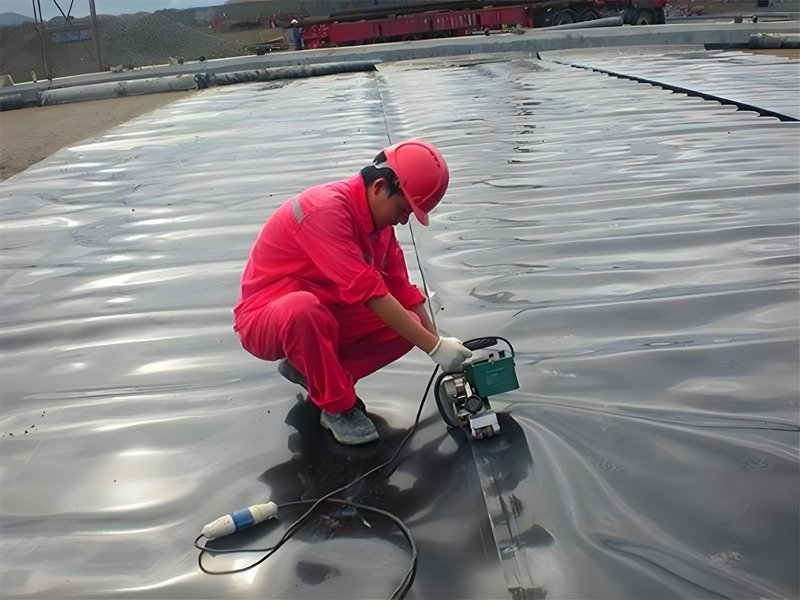
2.Why Chose High Density Polyethylene Liner for Biogas Pond Project?
There are several reasons why High Density Polyethylene (HDPE) liners are commonly chosen for biogas pond projects:
2.1 Impermeability
High Density Polyethylene Liners excel in their ability to prevent the leakage of methane gas, the primary component of biogas. Their superior impermeability ensures optimal gas retention within the biogas pond, leading to increased gas production and reduced losses.
2.2 Chemical Resistance
High Density Polyethylene Liners offer exceptional resistance to corrosive and acidic substances typically found in biogas ponds. Their robust chemical resistance shields against the corrosive nature of biogas and associated chemicals, guaranteeing long-term durability and minimizing the risk of degradation or failure.
2.3 Flexibility and Durability
High Density Polyethylene Liners showcase remarkable flexibility, enabling them to conform seamlessly to irregular pond shapes and contours. This flexibility simplifies installation and ensures a secure fit, minimizing the possibility of leaks or breaches. Furthermore, HDPE liners exhibit impressive durability, capable of withstanding mechanical stresses, temperature fluctuations, and environmental factors commonly encountered in biogas pond applications.
2.4 Longevity
High Density Polyethylene Liners boast an extensive service life, often surpassing several decades. They are resistant to UV radiation, moisture, microbial degradation, and other environmental influences. This longevity ensures sustained performance and effectiveness throughout the lifespan of the biogas pond, providing long-term reliability.
2.5 Cost-effectiveness
High Density Polyethylene Liners offer a cost-effective solution for biogas pond projects. They are relatively economical compared to alternative liner materials such as concrete or clay. Additionally, their straightforward installation, low maintenance requirements, and extended lifespan contribute to overall cost savings over the course of the project.
3.How to install High Density Polyethylene Liner for Biogas Pond?
Installing a High Density Polyethylene (HDPE) liner for a biogas pond requires careful planning and execution. Here are the general steps involved in the installation process:
3.1 Preparation
Prior to installing the geosynthetic membrane, it is essential to adequately prepare the installation site. This involves clearing away any debris, rocks, or sharp objects that could potentially cause damage to the membrane. Creating a smooth and even surface is crucial for establishing a stable foundation.
3.2 Handling and Storage
Exercise caution when handling the geosynthetic membrane to prevent punctures or tears. Store the materials in a clean and protected area, away from potential hazards such as heavy machinery or sharp objects that could compromise their integrity.
3.3 Seaming Techniques
Utilize appropriate seaming techniques recommended by the manufacturer to connect multiple sections of the geosynthetic membrane. Common methods include thermal welding, adhesive bonding, or mechanical fastening. Adhere to proper procedures to achieve robust and watertight seams.
3.4 Overlaps and Edges
Ensure there is sufficient overlap between adjacent sections of the geosynthetic membrane. The recommended overlap width will depend on the specific project and material specifications. Pay careful attention to the edges of the membrane to prevent exposure or vulnerability to damage.
3.5 Anchoring and Fixing
Effectively anchor and secure the geosynthetic membrane to prevent any movement or displacement. This can be accomplished through trenching, ballasting, or mechanical fastening methods. The anchoring system should provide ample tension and securely hold the membrane in place.
3.6 Environmental Conditions
Consider the impact of environmental conditions on the installation process. Extreme temperatures, high winds, or heavy rainfall can affect the handling and performance of the geosynthetic membrane. Take appropriate measures to mitigate potential risks.


4.Case Study of High Density Polyethylene Liner for Biogas Pond Project in Dezhou
In biogas pond facilities, the prevalent choice for polyethylene liners is a formulation comprising high-density polyethylene blended with carbon black, anti-aging agents, anti-oxygen agents, UV absorbers, stabilizers, and other auxiliary materials. At this particular facility, the BPM polyethylene liner has been installed, featuring smooth surfaces that contribute to a notable reduction in interface shear resistance.
The selection of a reliable and well-designed polyethylene liner, such as BPM’s product, ensures the effective containment of biogas and the protection of surrounding soil and groundwater from potential contamination. The smooth surface characteristics and low interface shear resistance of the BPM polyethylene liner make it a suitable choice for the specific requirements of biogas pond facilities.
BPM took on a medium-sized project involving an impermeable biogas polyethylene liner at Lia Ranch in Dezhou, Shandong province, China. The Construction Department of Shandong Province mandated that the biogas pond must meet specified requirements in terms of impermeability and volume. Our company served as the supplier for the Dezhou Lia Ranch Biogas Pond Project, actively participating in various aspects such as project planning, design, and installation.
The biogas polyethylene liner used in this project consisted of two main components: the substrate and the mask. The substrate acted as a barrier at the bottom of the biogas pond liner to prevent seepage, while the mask served as a sealant for the liner.
After extensive exchanges and on-site assessments, both parties agreed to use BPM’s 1.0mm-size polyethylene liner as the substrate layer and BPM’s 1.5mm-size impermeable liner as the mask layer for the biogas pond. This decision was made in accordance with the project requirements and specifications.
With over a decade of experience in constructing impermeable biogas ponds, BPM successfully completed the project under the guidance of Engineer Zhang.
5.Summary
BPM had provided many types of effective and state of the art geotextile, geomembrane and geosythetics products to over 100 countries. Our main innovative, high quality geosynthetics products include geomembranes, geotextiles, geocell, geosynthetic clay liners (GCLs), drainage boards, geogrids, etc. BPM brand geosynthetics had been certificated by the ISO9001, ISO14001,OHSAS18001 Soncap, SASO and BV certificates and passed the test of SGS and Intertek, etc.
BPM is also providing professional design and installation service. OEM and ODM are also available. If you have any questions or inquiries, please contact us, we will reply as soon as possible.

